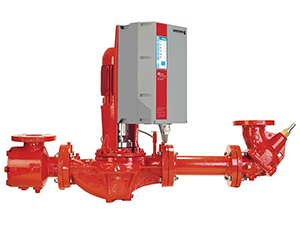
Many familiar with vertical inline (VIL) pumps—such as the Armstrong 4300 Series pumps—and their numerous benefits wonder why base-mounted pumps are still being specified and installed considering their antiquity and being more costly to install.
Side-by-Side Comparison
If you’re still not sold on inline vs. base-mounted pumps, here is a comparison:
| Vertical Inline Pumps | Base-Mounted Pumps |
|---|---|
| No alignment necessary, ever | Need to be field aligned at installation, ideally using lasers, and after any service or seal change |
| Split-coupling allows seal change in 15 to 20 minutes time | Seal changes can be difficult with some base-mounted pumps requiring two seals |
| No additional items are required due to not being mounted on the floor | Requires inlet/outlet flex connectors, possible inertia base with isolators, a concrete pad, and base grouting |
| Inherently reduce vibration due to vertical design, like a spinning top | Frequent vibration problems |
| Variable frequency drive (VFD) motor mounted with no other requirements so it operates with sensor-less or building management system (BMS) control; electronically commuted motors (ECM) are available up to 50 HP | VFDs mounted remotely – extra cost for mounting, control and power wiring as well as pressure differential sensors required |
| Reduced footprint, can be stacked, elevated or in a row, requiring less overall piping | Large footprint, horizontal split-case even larger |
Consider Inline Pumps on Your Next Project
We know that contractors sometimes hesitate to implement inline pumps because it’s often designed the old way – engineers have specified base-mounted pumps for a long time. That’s why it’s important for inline pumps to be specified at the outset. If they’re not, Maddock Industries can help you make the case.
When you go inline, you’ll never go back to base-mounted.
